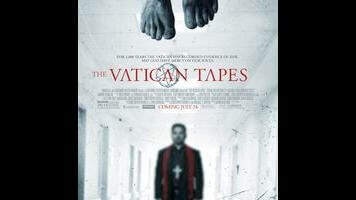Mark Neveldine breaks from his longtime creative partner Brian Taylor for his solo feature-directing debut The Vatican Tapes, and in the process he seems to have lost the spark of madness that lit up his and Taylor’s collaborations on the likes of Crank and Gamer. The Neveldine/Taylor films are rocket-paced and super-stylish, mimicking the constant distractions and free-floating mayhem of modern life. The Vatican Tapes is comparatively inert, even though it features a lot of the askew camera angles and jump-cuts that fans of the Crank series expect. Shot in 2013, this low-budget horror picture is reaching screens somewhat belatedly, and with minimal fanfare given the director’s cult following. In nearly every way—from how the movie’s being released to the way it approaches the whole satanic possession subgenre—The Vatican Tapes is dispiritingly ordinary. It’s the rote B-movie that Neveldine up to now has tried so hard not to make.
The film does get off to a good start, with an opening credits sequence that flips rapidly between home videos, news reports, and surveillance footage, all documenting a spreading plague of demonic possession that the Vatican is supposedly suppressing. Images of twisted, floating bodies pop onto the screen in an unsettling barrage, which bears little to no resemblance to the clumsy, truncated Exorcist knockoff that follows. After that few minutes of setup, Neveldine and screenwriters Christopher Borrelli and Michael C. Martin quickly move away from the whole idea of a global phenomenon/conspiracy, and instead focus on one pleasant young woman who’s turning freaky and evil.
Olivia Taylor Dudley plays the woman, Angela Holmes: the daughter of an army officer (Dougray Scott) and the prostitute that he once tried to reform. Angela’s erratic behavior alarms her dad and her boyfriend Pete, especially when a car accident puts her into a months-long coma. Even after she awakes, Angela periodically slips into a trance, during which she gets pretty dark—trying to drown a newborn baby at one point, and later forcing a security guard to crush lightbulbs into his eyes. When Angela’s psychiatrist fails to fix her, a naive Catholic priest named Father Lozano (Michael Peña) steps in, operating under the guidance of a hard-bitten cardinal (Peter Andersson). What comes next is a lot of familiar scenes of solemn men waving crosses and muttering Latin while a woman jerks around violently and snarls in a throaty voice.
The Vatican Tapes eventually arrives at a plot point that sets up what could’ve been an exciting and maybe even redemptive third act. Instead the movie just ends, presumably opening the door for a sequel that could potentially take this over-familiar premise into new places. But aside from the promise of a fresher plot, there’s nothing in The Vatican Tapes that demands to be revisited. The characters are blanks: They’re just “the young woman,” “the boyfriend,” and “the priest,” with little personality or nuance. And aside from a few striking images and camera moves sprinkled throughout, there’s not a lot of stylistic flair here.
The most memorable scene in the entire picture is the one where the exorcist compels Angela to vomit up three whole eggs, representing the Holy Trinity. That’s just the kind of weird touch that made Neveldine’s earlier films hard to dismiss, even at their most undisciplined. Here, it’s an anomaly—the rare moment that suggests this movie might have an original soul within its cloned body. But even those eggs are nothing special. Like the rest of the movie, they look plain, dry, and lukewarm.

